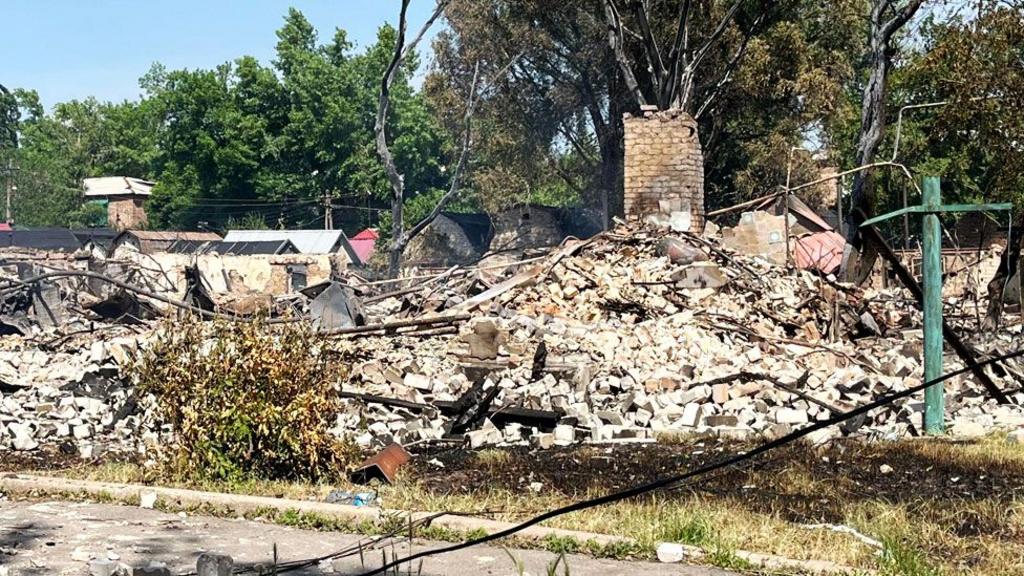A pungent odor permeates Rodynske. Moments after entering, the source becomes horrifyingly clear: a 250kg glide bomb has devastated the town’s administrative building and three residential blocks. Though a day has passed since the attack, smoldering wreckage remains. Artillery fire and the distinct crackle of Ukrainian soldiers engaging drones echo from the outskirts.
Rodynske, situated approximately 15km (9 miles) north of embattled Pokrovsk, has been a target of Russian advances from the south since last autumn. Ukrainian forces have successfully repelled direct assaults, prompting a shift in Russian tactics to encirclement, focusing on severing supply lines.
This intensified push, coinciding with the failure of recent diplomatic ceasefire efforts, marks Russia’s most significant gains since January. Rodynske bears stark testament to this escalation.
Upon arrival, a Russian drone appears overhead, forcing our team to seek immediate cover behind a tree. A subsequent explosion signals another drone strike nearby. The persistent whirring of the drone above underscores the terrifying reality of this war’s deadliest weapon.
After securing cover in an abandoned building, the drone’s return is suspected, indicating a closer-than-expected launch point. The drone attacks suggest a new launch location in recently captured territory along a key road linking Pokrovsk and Kostyantynivka.
Following a tense half-hour, a hasty retreat ensues. Smoke billowing beside the highway suggests a downed drone. In nearby Bilytske, a missile strike has ravaged homes, including that of Svitlana, who recounts the escalating threat, noting the increasingly close proximity of attacks.
At a safe location, we speak with soldiers from the 5th Assault Brigade’s artillery unit. Serhii describes the increased intensity of Russian assaults utilizing rockets, mortars, and drones to disrupt supply routes.
Their deployment awaits favorable weather conditions to shield them from drone surveillance. The conflict’s rapidly changing landscape highlights the emergence of fiber optic drones—a significant technological challenge.
Moderator, a drone engineer with the 68th Jaeger Brigade, explains the invulnerability of these drones to electronic warfare systems due to their fiber optic cable connection. This advantage currently favors Russia, while Ukraine races to increase production.
Venia, a drone pilot with the 68th Jaeger Brigade, emphasizes their unique operational capabilities, allowing infiltration into buildings. Although slower and susceptible to entanglement, their widespread use has made troop transportation exceptionally perilous.
Oles, Chief Sergeant of the 5th Assault Brigade’s reconnaissance unit, describes the constant threat and the extended deployments now necessary. A rare encounter with infantrymen at a makeshift base reveals the grueling realities faced at the frontline.
Maksym, a soldier, recounts deployments exceeding 30 days—a stark contrast to pre-drone rotations. His account underscores the relentless pressure and constant alertness demanded by the intensified fighting.
Oles notes a shift in Russian infantry tactics, using smaller units and varied transport, blurring frontlines into a complex, intertwined engagement. This complexity masks the advances of both sides.
Despite recent Russian gains, capturing the entire Donetsk region, where Pokrovsk is located, won’t be swift or easy. Ukraine’s defense is robust, but sustaining the fight requires consistent weapon and ammunition supplies and addresses manpower challenges against a larger Russian army.
Many soldiers encountered joined after the war’s onset, having undergone limited training. Maksym, formerly employed by a beverage company, shares the emotional toll on his family, particularly his two-year-old son.
Additional reporting by Imogen Anderson, Sanjay Ganguly, Volodymyr Lozhko and Anastasiia Levchenko
A brand new statue of the Soviet dictator Josef Stalin has been unveiled at a Metro station in Moscow.
Friedrich Merz said earlier there were “no longer” any range restrictions on weapons supplied by Kyiv’s Western allies.
Relations between war-torn Ukraine and its Nato neighbour Hungary plummet to a new low.
The advance may be linked to Moscow’s attempts to create “buffer zones” along the border, Ukrainian regional authorities say.
Residents say tourists flying drones are invading their privacy.

